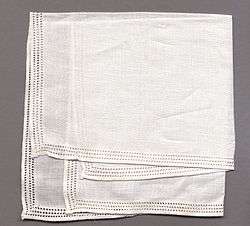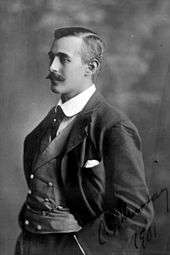Handkerchief

A handkerchief /ˈhæŋkərtʃɪf/, also called a handkercher or hanky, is a form of a kerchief, typically a hemmed square of thin fabric that can be carried in the pocket or purse, and which is intended for personal hygiene purposes such as wiping one's hands or face, or blowing one's nose. A handkerchief is also sometimes used as a purely decorative accessory in a suit pocket, it is then called a pocket square.
Modern usage
The material of a handkerchief can be symbolic of the social-economic class of the user, not only because some materials are more expensive, but because some materials are more absorbent and practical for those who use a handkerchief for more than style. Handkerchiefs can be made of cotton, cotton-synthetic blend, synthetic fabric, silk, or linen.
Handkerchiefs were also used, especially by children, as an impromptu way to carry around small items when a bag or basket was unavailable. They could also serve as a substitute for a bandage over a small injury. In the United Kingdom, the habit of wearing a handkerchief with tied corners on one's head at the beach has become a seaside postcard stereotype, referenced by the Gumby characters in Monty Python's Flying Circus.
Signals may also be sent by handkerchief, such as the American LGBT handkerchief codes. In Spanish football or in bullfighting, it is a common sight to see supporters waving white handkerchiefs as an expression of deep emotion. It is used both positively, in admiration of an exceptional performance by a team or player, or as a negative sign of disgust at an especially bad performance.
From the late 18th century white handkerchiefs were waved, generally by women (men usually waved their hats), to demonstrate approval at public events such as processions or political rallies.[1][2]
Using handkerchiefs to accentuate hand movements while dancing is a feature of both West African and African-American traditional dance, in the latter case especially in wedding celebrations.[3] Handkerchiefs are also traditional accoutrements in certain kinds of English folk-dance.
Besides their intended use, they could be used for cleaning equipment, polishing shoes, cleaning hands and face, signalling for attention, as a sweat band, neckerchief, as protection from dust inhalation, to repair footwear, cut out pieces to patch clothes, cut up as emergency firearms cleaning patches, Molotov cocktail wick (fire-bomb), hot cooking utensil holder, a makeshift bandage, tourniquet or arm sling.
Origin

Before people used the word handkerchief, the word kerchief alone was common. This term came from two French words: couvrir, which means “to cover,” and chef, which means “head.”
In the times of ancient Greece and Rome, handkerchiefs were often used the way they are today. But in the Middle Ages, kerchiefs were usually used to cover the head.
Then in the 16th century, people in Europe began to carry kerchiefs in their pockets to wipe their forehead or their nose. To distinguish this kind of kerchief from the one used to cover the head, the word "hand" was added to "kerchief".
King Richard II of England, who reigned from 1377 to 1399, is widely believed to have invented the cloth handkerchief, as surviving documents written by his courtiers describe his use of square pieces of cloth to wipe his nose.[4] Certainly they were in existence by Shakespeare's time, and a handkerchief is an important plot device in his play Othello.
Pocket square



In addition to carrying for practical purposes, handkerchiefs have long been displayed in the top pocket of men's jackets. Used in this way, they are referred to as a pocket handkerchief or pocket square. A traditional pocket square will have the hem rolled, contrary to handkerchiefs.
The trend of pocket square as a fashion accessory have really started during the 1920s, and was considered a trendy accessory up until the Sixties, where actors such as Cary Grant, Fred Astaire or Gary Cooper used to wear them regularly. Il felt into disuse up until the 1990s, where pocket square made a come-back, thanks to popular tv shows such as Mad Men.
Pocket squares are usually made in fabrics such as silk, cotton, linen or wool.
As a visible fashion item there are a wide variety of ways to fold a pocket square,[5] ranging from the austere to the flamboyant:
- The Presidential, or Flat Fold, perhaps the simplest, is folded at right angles to fit in the pocket.
- The Winged Puff, a simple and elegant fold.
- The Puff or the Cooper is simply shaped into a round puff.
- The Reverse Puff, or The Crown Fold,[6] is like the Puff, except with the puff inside and the points out, like petals.
- The Westo Four Point fold, the quickest way to achieve a four-point fold effect.
- The TV Fold looks similar but is folded diagonally with the point inside the pocket.
- The One-point Fold is folded diagonally with the point showing.
- The Two-point Fold is folded off-center so the two points do not completely overlap.
- The Three-point Fold is first folded into a triangle, then the corners are folded up and across to make three points.
- The Four-point Fold is an off-center version of the Three-point Fold.
- The Cagney is basically a backwards version of the Four-point Fold.
- The Astaire is a puff with a point on either side.
- The Straight Shell is pleated and then folded over to give the appearance of nested shells.
- The Diagonal Shell is pleated diagonally and then folded.
See also
- Napkin
- Sachet
- Facial tissue
- Antimacassar
- Dudou, sometimes described as a handkerchief blouse
References
- ↑ "Mr. PITT's carriage was nearly the last...he was received with very general applause; the ladies waving their white handkerchiefs from the windows as he passed." "The Procession To St. Paul's." Times [London, England], 20 December 1797, p.2
- ↑ General Lafayette was greeted on a visit to Providence, R.I., by "nearly 200 Misses, arrayed in white," who strewed flowers in his path "at the same time waving their white handkerchiefs." "Lafayette In America." Times [London, England] 16 October 1824, p. 2
- ↑ 'Information About Dancing And Waving White Handkerchiefs In Ewe Cultures Of Ghana & Togo And The Igbo Culture Of Nigeria' Edited by Azizi Powell
- ↑ Tuchman, Barbara. A Distant Mirror, 473.
- ↑ "How to fold a pocket square? - Pochette Square". www.pochette-square.com. Retrieved 2016-11-29.
- ↑ "How to fold a pocket square? - Pochette Square". www.pochette-square.com. Retrieved 2016-11-29.
External links
| Wikimedia Commons has media related to Handkerchiefs. |
- "How to fold a pocket square". Pochette Square. 29 November 2016. Retrieved 29 November 2016.
- "How to wear a pocket square". Pochette Square. 29 November 2016. Retrieved 29 November 2016.